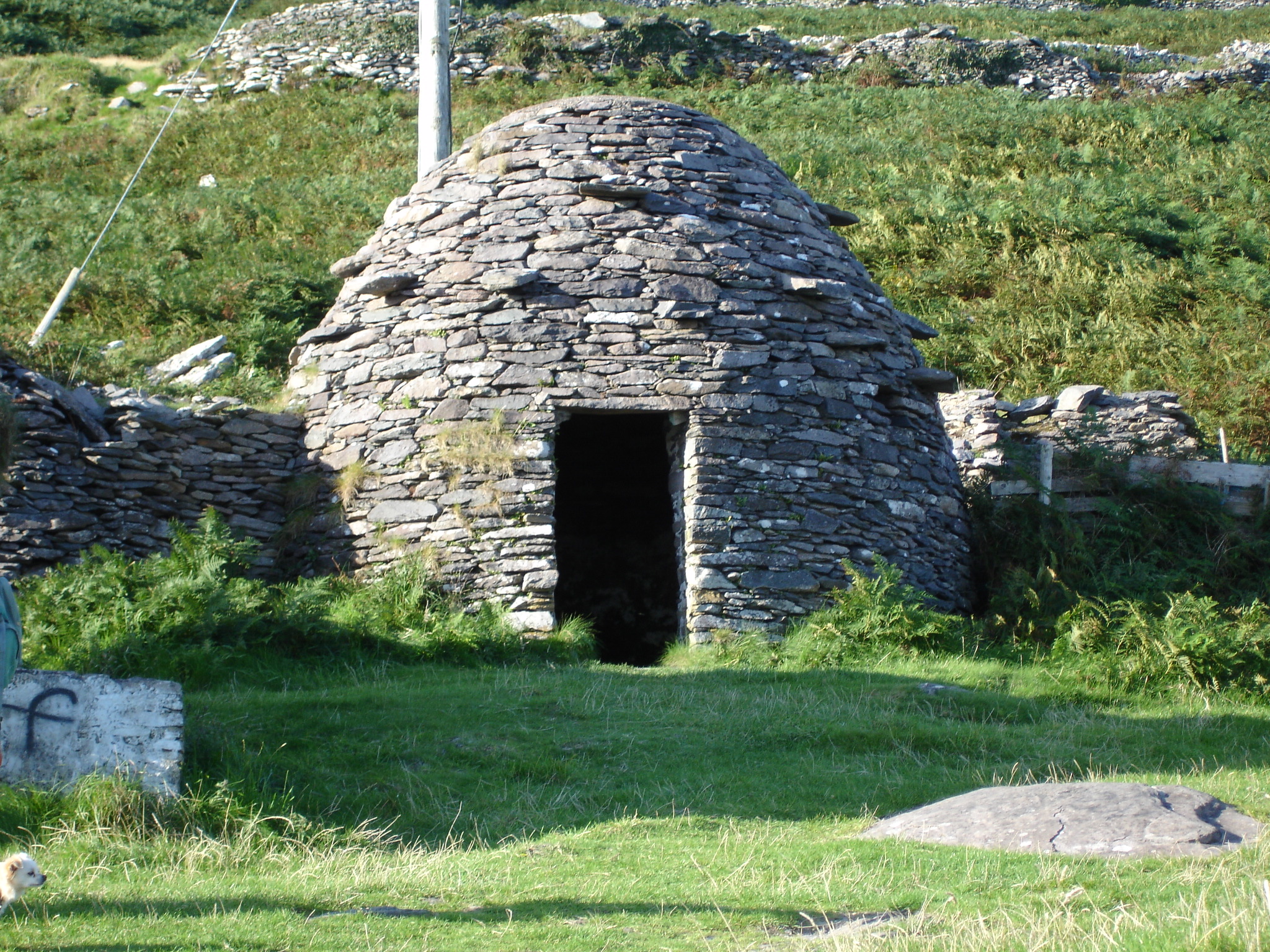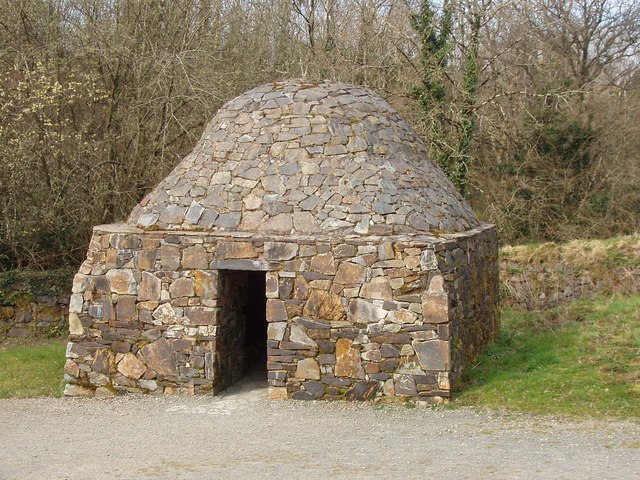Cloch%C3%A1n on:
[Wikipedia]
[Google]
[Amazon]

 A clochán (
A clochán (
The Archaeology of Early Medieval Ireland
', London: Batsford * Aalen, F. H. A. (1964)
Clochans as Transhumance Dwellings in the Dingle Peninsula, Co. Kerry
' * Henry, Françoise (1948)
Early Irish Monasteries, Boat-Shaped Oratories and Beehive Huts
' * Henry, Françoise (1956/1957)
Early Monasteries, Beehive Huts, and Dry-Stone Houses in the Neighbourhood of Caherciveen and Waterville (Co. Kerry)
' * Peter Harbison (1970), "How old is Gallarus oratory? A reappraisal of its role in early Irish architecture", ''Medieval Archeology'', Vol. XIV, pp. 34–59
 A clochán (
A clochán (plural
The plural (sometimes list of glossing abbreviations, abbreviated pl., pl, or ), in many languages, is one of the values of the grammatical number, grammatical category of number. The plural of a noun typically denotes a quantity greater than the ...
clocháin) or beehive hut is a dry-stone hut with a corbel
In architecture, a corbel is a structural piece of stone, wood or metal jutting from a wall to carry a superincumbent weight, a type of bracket. A corbel is a solid piece of material in the wall, whereas a console is a piece applied to the s ...
led roof, commonly associated with the south-western Irish seaboard. The precise construction date of most of these structures is unknown with the buildings belonging to a long-established Celtic tradition, though there is at present no direct evidence to date the surviving examples before . Some associated with religious sites may be pre-Romanesque, some consider that the most fully intact structures date after the 12th century or later. It is where monks lived.
Form
They are most commonly round beehive huts, but rectangular plans are known as well. It has been suggested that the rectangular footprints date to a later era. Some clochán are not completely built of stone and may have possessed a thatched roof. The walls are very thick, up to . Sometimes several clochans are joined together by their walls.Locations
Clochán are mainly found in the Southwest ofIreland
Ireland ( ; ga, Éire ; Ulster-Scots: ) is an island in the North Atlantic Ocean, in north-western Europe. It is separated from Great Britain to its east by the North Channel, the Irish Sea, and St George's Channel. Ireland is the s ...
, for example at Skellig Michael, Church Island off Beginish Island, Glanfahan, Fahan and Reask in the Dingle Peninsula
The Dingle Peninsula ( ga, Corca Dhuibhne; anglicised as Corkaguiny, the name of the corresponding barony) is the northernmost of the major peninsulas in County Kerry. It ends beyond the town of Dingle at Dunmore Head, the westernmost point ...
of County Kerry
County Kerry ( gle, Contae Chiarraí) is a county in Ireland. It is located in the South-West Region and forms part of the province of Munster. It is named after the Ciarraige who lived in part of the present county. The population of the co ...
. Many occur in religious contexts such as used by the monks following Saint Patrick
Saint Patrick ( la, Patricius; ga, Pádraig ; cy, Padrig) was a fifth-century Romano-British Christian missionary and bishop in Ireland. Known as the "Apostle of Ireland", he is the primary patron saint of Ireland, the other patron saints b ...
; moreover, his successors carried on the architectural tradition in the Scottish island of Iona
Iona (; gd, Ì Chaluim Chille (IPA: �iːˈxaɫ̪ɯimˈçiʎə, sometimes simply ''Ì''; sco, Iona) is a small island in the Inner Hebrides, off the Ross of Mull on the western coast of Scotland. It is mainly known for Iona Abbey, though ther ...
and eventually via Aidan
Aidan or Aiden is a modern version of a number of Celtic language names, including the Irish male given name ''Aodhán'', the Scottish Gaelic given name Aodhan and the Welsh name Aeddan. Phonetic variants, such as spelled with an "e" instead o ...
to the eastern English islands of Farne and Holy Island
Sacred space, sacred ground, sacred place, sacred temple, holy ground, or holy place refers to a location which is deemed to be sacred or hallowed. The sacredness of a natural feature may accrue through tradition or be granted through a bles ...
. There are others in ringfort
Ringforts, ring forts or ring fortresses are circular fortified settlements that were mostly built during the Bronze Age up to about the year 1000. They are found in Northern Europe, especially in Ireland. There are also many in South Wale ...
s (such as Leacanabuaile, County Kerry
County Kerry ( gle, Contae Chiarraí) is a county in Ireland. It is located in the South-West Region and forms part of the province of Munster. It is named after the Ciarraige who lived in part of the present county. The population of the co ...
) that are commonly interpreted as secular dwellings. Elaborate dry walled stone churches like the Gallarus Oratory
The Gallarus Oratory (, ''Gallarus'' being interpreted as either 'rocky headland' (''Gall-iorrus'') or 'house or shelter for foreigner(s)' (''Gall Aras'') is a chapel on the Dingle Peninsula, County Kerry, Ireland. It has been presented variou ...
may derive from the clochán. The clochán has been described in the 7th to 8th-century law Críth Gablach.
Popular culture
Parts of the 2017 film Star Wars: The Last Jedi were filmed using the beehive huts on the island of Skellig Michael. Because of the restrictions regarding filming on the island, a set of replica beehive huts were also built in 2016 at Ceann Sibéal, near Ballyferriter, on theDingle Peninsula
The Dingle Peninsula ( ga, Corca Dhuibhne; anglicised as Corkaguiny, the name of the corresponding barony) is the northernmost of the major peninsulas in County Kerry. It ends beyond the town of Dingle at Dunmore Head, the westernmost point ...
.
See also
* Beehive house *Christian monasticism
Christian monasticism is the devotional practice of Christians who live ascetic and typically cloistered lives that are dedicated to Christian worship. It began to develop early in the history of the Christian Church, modeled upon scriptural ex ...
* Chysauster Romano-British settlement in southwest Britain
*Cleit
A cleit is a stone storage hut or bothy, uniquely found on the isles and stacs of St Kilda; whilst many are still to be found, they are slowly falling into disrepair. There are known to be 1,260 cleitean on Hirta and a further 170 on the other ...
*Dry stone
Dry stone, sometimes called drystack or, in Scotland, drystane, is a building method by which structures are constructed from stones without any mortar to bind them together. Dry stone structures are stable because of their construction me ...
*Hermits
A hermit, also known as an eremite (adjectival form: hermitic or eremitic) or solitary, is a person who lives in seclusion. Eremitism plays a role in a variety of religions.
Description
In Christianity, the term was originally applied to a Ch ...
*Vernacular architecture
Vernacular architecture is building done outside any academic tradition, and without professional guidance. This category encompasses a wide range and variety of building types, with differing methods of construction, from around the world, bo ...
Further reading
* Olsen, B. (2003) ''Sacred Places North America'', Santa Cruz, California: CCC Publishing * Edwards, Nancy (1990)The Archaeology of Early Medieval Ireland
', London: Batsford * Aalen, F. H. A. (1964)
Clochans as Transhumance Dwellings in the Dingle Peninsula, Co. Kerry
' * Henry, Françoise (1948)
Early Irish Monasteries, Boat-Shaped Oratories and Beehive Huts
' * Henry, Françoise (1956/1957)
Early Monasteries, Beehive Huts, and Dry-Stone Houses in the Neighbourhood of Caherciveen and Waterville (Co. Kerry)
' * Peter Harbison (1970), "How old is Gallarus oratory? A reappraisal of its role in early Irish architecture", ''Medieval Archeology'', Vol. XIV, pp. 34–59
References
External links
{{DEFAULTSORT:Clochan Stone houses Buildings and structures in Ireland Vernacular architecture Roofing materials Irish Christian monks Monasticism Archaeological sites in County Kerry Ruins in the Republic of Ireland Christian monasteries in the Republic of Ireland